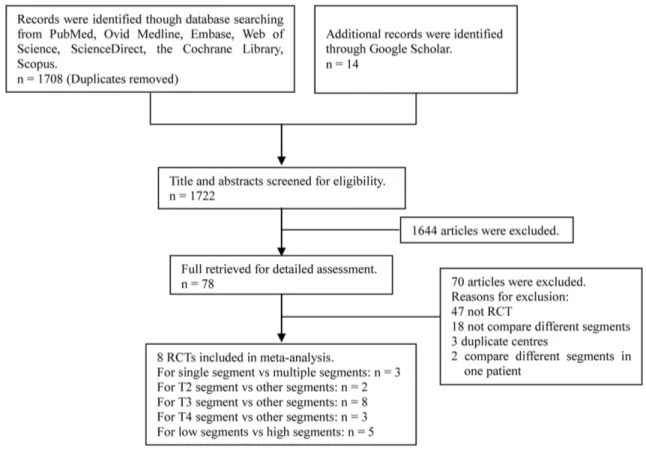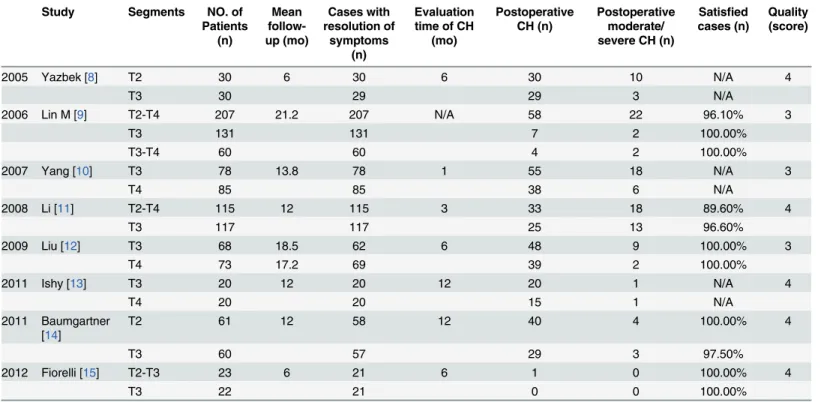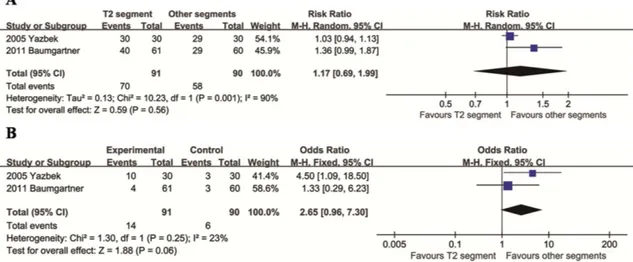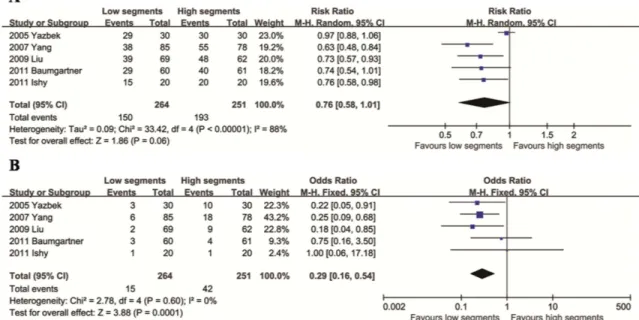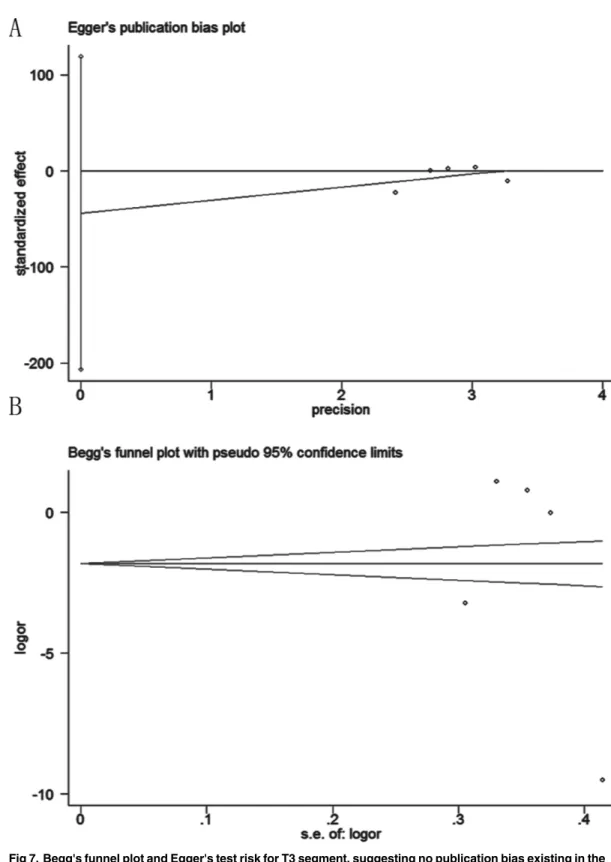Video-Assisted Thoracoscopic
Sympathectomy for Palmar Hyperhidrosis: A
Meta-Analysis of Randomized Controlled
Trials
Wenxiong Zhang, Dongliang Yu, Han Jiang, Jianjun Xu, Yiping Wei*
Department of Cardiothoracic Surgery, The Second Affiliated Hospital of Nanchang University, Nanchang, China
*weiyiping2015@163.com
Abstract
Objectives
Video-assisted thoracoscopic sympathectomy (VTS) is effective in treating palmar hyperhi-drosis (PH). However, it is no consensus over which segment should undergo VTS to maxi-mize efficacy and minimaxi-mize the complications of compensatory hyperhidrosis (CH). This study was designed to compare the efficiency and side effects of VTS of different segments in the treatment of PH.
Methods
A comprehensive search of PubMed, Ovid MEDLINE, EMBASE, Web of Science, Science-Direct, the Cochrane Library, Scopus and Google Scholar was performed to identify studies comparing VTS of different segments for treatment of PH. The data was analyzed by Rev-man 5.3 software and SPSS 18.0.
Results
A total of eight randomized controlled trials (RCTs) involving 1200 patients were included. Meta-analysis showed that single segment/low segments VTS could reduce the risk of mod-erate/severe CH compared with multiple segments/high segments. The risk of total CH had a similar trend. In the subgroup analysis of single segment VTS, no significant differences were found between T2/T3 VTS and other segments in postoperative CH and degree of CH. T4 VTS showed better efficacy in limiting CH compared with other segments.
Conclusions
T4 appears to be the best segment for the surgical treatment of PH. Our findings require fur-ther validation in more high-quality, large-scale randomized controlled trials.
a11111
OPEN ACCESS
Citation:Zhang W, Yu D, Jiang H, Xu J, Wei Y (2016) Video-Assisted Thoracoscopic
Sympathectomy for Palmar Hyperhidrosis: A Meta-Analysis of Randomized Controlled Trials. PLoS ONE 11(5): e0155184. doi:10.1371/journal.pone.0155184
Editor:Hyun-Sung Lee, Baylor College of Medicine, UNITED STATES
Received:March 20, 2016
Accepted:April 25, 2016
Published:May 17, 2016
Copyright:© 2016 Zhang et al. This is an open access article distributed under the terms of the
Creative Commons Attribution License, which permits unrestricted use, distribution, and reproduction in any medium, provided the original author and source are credited.
Data Availability Statement:All relevant data are within the paper.
Funding:These authors have no support or funding to report.
Introduction
Primary palmar hyperhidrosis (PH) is a condition marked by excessive perspiration beyond
physiologic need, and is aggravated during periods of stress and anxiety [1,2]. Video-assisted
thoracic sympathectomy (VTS) is currently used worldwide in the treatment of PH. This tech-nique has become popular because of the low morbidity and mortality, and the benefits of
min-imally invasive surgery offered to the patients [3,4]. Compensatory hyperhidrosis (CH) is the
most common side effect of VTS and has a negative impact on patient’s postoperative quality
of life [5]. The relationship of CH to the degree of sympathectomy has been the subject of intense debate among thoracic surgeons [6], partly due to the lack of large-scale clinical research in the area. To determine which segment of the nerve gives the best results post VTS, we performed a meta-analysis of randomized clinical trial data in this area.
Materials and Methods
Search strategy
The study was conducted according to the Preferred Reporting Items for Systematic Reviews
and Meta-Analyses criteria (PRISMA) as shown inS1 File. A MEDLINE search was performed
by two investigators, independently and in duplicate, to identify all relevant scientific literature published up to January 2016. The search included the following databases: PubMed, Ovid MEDLINE, Embase, Web of Science, ScienceDirect, The Cochrane Library, Scopus and Google
Scholar. The MeSH terms“hyperhidrosis”,“sympathectomy or sympathicotomy”and“
com-parative study”were used.
The following types of trial were included: (1) randomized controlled trials (RCTs); (2) trials compared VTS in different segments when treating patients with palmar hyperhidrosis. When data or data subsets were reported in more than one article, the article with the most detail or the most recent article was chosen. Case-only designs, case reports, systematic reviews, meta-analyzes, animal studies, or studies with duplicated data were excluded.
Data extraction
Two investigators independently extracted data from all eligible studies. The data included first author, year of publication, study design, surgical segments, number of patients per group, fol-low-up period, evaluation time of CH, clinical outcomes (postoperative resolution of symp-toms), satisfied cases and postoperative degree of CH.
Quality assessment of included studies
Two investigators independently assessed the quality of each study using the Jadad scale [7]. This scale is scored according to the presence of three key methodological features: randomiza-tion, blinding and accountability of all patients, including withdrawals and dropouts. Studies
are considered good quality if they score3 points.
Statistical analysis
The data were analyzed using Review Manager 5.3 software (The Nordic Cochrane Centre, The Cochrane Collaboration, Copenhagen, Denmark), SPSS 18.0 (International Business Machines Corporation, Armonk, USA) and STATA 12.0 (StataCorp. LP, College Station, Texas, USA). For continuous outcomes, we calculated the mean difference weighted by the inverse of the variance. For dichotomous variables, the relative risk was calculated between two
groups with 95% confidence intervals. The Cochrane Q andI2statistics were included to
orp0.10 butI250%); otherwise, a random-effects model was adopted. A two-tailed p
of0.05 was deemed statistically significant.
Results
Search results and quality assessment of included studies
Of the 1722 publications initially identified from the database and reference list searches, we selected eight RCTs for final analysis (Fig 1). The articles involved a total of 1200 patients, with a male:female ratio of 597:603. All patients underwent a bilateral sympathectomy in one stage. According to the Jadad scale, all eight articles were all of good quality, and the baseline
charac-teristics of these articles are listed inTable 1.
We evaluated three aspects of the operation: (1) resolution of symptoms; (2) patient satisfac-tion; (3) postoperative complications. In the meta-analysis, we found no significant difference
in“resolution of symptoms”and“patient satisfaction”between different segments (p>0.05).
The data suggest that VTS of all segments could improve the symptom of hyperhidrosis, with a satisfaction close to 100% in all segments. CH was the most common complication reported and, when severe, could significantly affect quality of life. In the present study, we took postop-erative degree of CH as the main index to evaluate the success of the operation.
Comparison of single segment and multiple segments
We identified three articles to compare VTS of a single segment and multiple segments. The mean difference in total CH between the two groups was not significant (95% confidence
Fig 1. Flow diagram of screened and included papers.
interval [CI]: 0.15 to 1.21,p= 0.11), with significant heterogeneity across studies (p= 0.02;
I2= 74%,Fig 2A). More severe CH was found in the multiple segments group (95% CI: 0.22 to
0.80,p= 0.008), with significant heterogeneity across studies (p= 0.07;I2= 69%,Fig 2A).
Comparison of T2 segment with other segments
We identified two articles to compare TVS of the T2 segment and other segments. The mean difference in total CH between the two groups was not significant (95% CI: 0.69 to 1.99,
Table 1. Summary of the eight studies included in the present meta-analysis.
Study Segments NO. of Patients (n) Mean follow-up (mo) Cases with resolution of symptoms (n) Evaluation time of CH
(mo)
Postoperative CH (n)
Postoperative moderate/ severe CH (n)
Satisfied cases (n)
Quality (score)
2005 Yazbek [8] T2 30 6 30 6 30 10 N/A 4
T3 30 29 29 3 N/A
2006 Lin M [9] T2-T4 207 21.2 207 N/A 58 22 96.10% 3
T3 131 131 7 2 100.00%
T3-T4 60 60 4 2 100.00%
2007 Yang [10] T3 78 13.8 78 1 55 18 N/A 3
T4 85 85 38 6 N/A
2008 Li [11] T2-T4 115 12 115 3 33 18 89.60% 4
T3 117 117 25 13 96.60%
2009 Liu [12] T3 68 18.5 62 6 48 9 100.00% 3
T4 73 17.2 69 39 2 100.00%
2011 Ishy [13] T3 20 12 20 12 20 1 N/A 4
T4 20 20 15 1 N/A
2011 Baumgartner [14]
T2 61 12 58 12 40 4 100.00% 4
T3 60 57 29 3 97.50%
2012 Fiorelli [15] T2-T3 23 6 21 6 1 0 100.00% 4
T3 22 21 0 0 100.00%
doi:10.1371/journal.pone.0155184.t001
Fig 2. Relative risks for total CH (A) and moderate/severe CH (B) in the single segment group compared to the multiple segment group.
p= 0.56), with significant heterogeneity across studies (p= 0.001;I2= 90%,Fig 3A). The mean difference in degree of CH between the two groups was not significant (95% CI: 0.96 to 7.30,
p= 0.06), with acceptable heterogeneity across studies (p= 0.07;I2= 69%,Fig 3B).
Comparison of T3 segment with other segments
We identified eight articles that compared T3 segment with other segments. The mean differ-ences between the two groups in both comparisons (total CH and degree of CH) were not
sig-nificant (p>0.05), with significant heterogeneity across studies (p<0.001;I2>70%,Fig 4).
Comparison of T4 segment with other segments
We identified three articles that compared VTS of the T4 segment and other segments, all of which compared T4 and T3. There was no evidence of heterogeneity between these studies
(I2= 0%). The results showed fewer total CH and moderate/severe CH in the T4 segment
group (p<0.001,Fig 5).
Comparison of low and high segments
We identified five articles that compared VTS of low and high segments (if T2 vs T3, T2 is the high segement and T3 is the low segment; if T3 vs T4, T3 is the high segement and T4 is the low segment). The mean difference in total CH between the two groups was not significant
(95% CI: 0.58 to 1.01,p= 0.06), with significant heterogeneity across studies (p<0.0001;I2=
88%,Fig 6A). There was no evidence of heterogeneity between these studies in the comparison
of CH degree (p= 0.60,I2= 0%). The results showed a lower degree of CH in the low segment
group (p= 0.0001,Fig 6B).
Publication Bias
Assessment of publication bias using Egger’s and Begg’s tests showed that no potential
publica-tion bias existed among the included trials (Egger’s test:p= 0.452; Begg’s test:p= 0.462) (Fig 7).
Fig 3. Relative risks for total CH (A) and moderate/severe CH (B) in the T2 segment group compared to the other segments group.
Discussion
VTS is now recognized as effective treatment of severe PH, and the development of an easy and safe video-assisted procedure has allowed for rapid spread of its application. VTS has been applied to various segments with different results. Traditionally, the T2 ganglion was regarded
Fig 4. Relative risks for total CH (A) and moderate/severe CH (B) in the T3 segment group compared to the other segments group.
doi:10.1371/journal.pone.0155184.g004
Fig 5. Relative risks for total CH (A) and moderate/severe CH (B) in the T4 segment group compared to the other segments group.
as the key pathway for the hands and was the most common site of VTS [16,17]. However, a
high incidence of severe CH affected quality of life after surgery [4,8,18]. Gray reported that
the preganglionic fibers to the arm originate mostly from the third to the sixth spinal segments and the third and fourth segments were considered as the main lesions [19]. The results of a study that compared VTS of the T2 and T3 suggest that avoiding the T2 ganglion might decrease the risk of CH [8]. Both T3 and T4 VTS have been reported in the past several years [12,20,21,22], resulting in fairly good results and a varying incidence of postoperative CH. At present, there remains a lack of expert consensus for the surgical procedure regarding the extent of denervation.
The present study included a total of 1200 patients with PH, providing the most compre-hensive evidence for segment selection of VTS. Our results showed that more moderate/severe CH was found after VTS of multiple segments and high segments. This result is similar to that found in a study which suggests that VTS of these segments could increase the incidence and severity of postoperative CH [6].
In the single segment subgroup, our results showed no significant differences between T2/ T3 VTS and other segments in terms of both total and degree of CH. T4 VTS was better at lim-iting CH compared to other segments. By chance, all studies in this review included only T4 and T3. It could therefore be considered as evidence that VTS of the T4 segment offers a better
chance of avoiding postoperative CH than T3 segment. Linet alconfirmed by nervous tract
mapping that neither T2 nor T3 are the major sympathetic innervation to hands and this role is performed by T4 and the lower ganglia; they also showed that only a small portion of the T3 sympathetic tone influences hand sweating. The authors therefore put forward the "Lin-Telar-anta classification" that blocking the T4 thoracic ganglion was suitable for PH with or without axillary hyperhidrosis [23].
The possible limitations of our study must be considered when interpreting the findings. First, only eight RCTs were included in the study, which might have weakened the quality of the results. Second, there was no uniform standard for evaluating the severity of postoperative
Fig 6. Relative risks for total CH (A) and moderate/severe CH (B) in the low segments group compared to the high segments group.
Fig 7. Begg's funnel plot and Egger's test risk for T3 segment, suggesting no publication bias existing in the pooled analysis.(A). Egger’s test,p= 0.452; (B). Begg's test,p= 0.462.
CH, which might increase the heterogeneity between studies. Third, the conclusion was proved by three indirect evidences, which might decrease the credibility of the conclusion. Fourth, the evaluation time of postoperative CH was not consistent in the reviewed studies, which might decrease the comparability of data.
Conclusion
VTS of high segments or multiple segments could increase the incidence and severity of post-operative CH. T4 seems to be the best segment for VTS as the surgical treatment of PH. How-ever, due to possible bias in the original studies, inter-study heterogeneity and the inherent limitations of our meta-analysis, this conclusion requires further validation by more high-qual-ity and large-scale RCTs.
Supporting Information
S1 File. PRISMA checklist.
(DOC)
Acknowledgments
Thanks are due to investigators, surgeons and patients who participated in this study.
Author Contributions
Conceived and designed the experiments: WXZ YPW. Performed the experiments: WXZ DLY HJ. Analyzed the data: WXZ DLY HJ. Contributed reagents/materials/analysis tools: WXZ JJX. Wrote the paper: WXZ. Revised the manuscript: WXZ DLY HJ JJX YPW.
References
1. Kauffman P, Cinelli M, Wolosker M, Leão LE. Treatment of palmar hyperhidrosis by cervico-thoracic sympathectomy. AMB Rev Assoc Med Bras 1978; 249(1): 29–30.
2. Baumgartner FJ, Toh Y. Severe hyperhidrosis: clinical features and current thoracoscopic surgical management. Ann Thorac Surg 2003; 76(6): 1878–1883. PMID:14667604
3. Landreneau RJ, Mack MJ, Hazelrigg SR, Dowling RD, Acuff TE, Magee MJ, et al. Video-assisted tho-racic surgery: basic technical concepts and intercostal approach strategies. Ann Thorac Surg 1992; 54 (4): 800–807. PMID:1417251
4. Ambrogi V, Campione E, Mineo D, PaternòEJ, Pompeo E, Mineo TC. Bilateral thoracoscopic T2 to T3 sympathectomy versus botulinum injection in palmar hyperhidrosis. Ann Thorac Surg 2009; 88(1): 238–245. doi:10.1016/j.athoracsur.2009.04.003PMID:19559233
5. Gossot D, Kabiri H, Caliandro R, Debrosse D, Girard P, Grunenwald D. Early complications of thoracic endoscopic sympathectomy: a prospective study of 940 procedures. Ann Thorac Surg 2001; 71(4): 1116–1119. PMID:11308146
6. Andrews BT, Rennie JA. Predicting changes in the distribution of sweating following thoracoscopic sympathectomy. Br J Surg 1997; 84(12): 1702–1704. PMID:9448619
7. Jadad AR, Moore RA, Carroll D, Jenkinson C, Reynolds DJ, Gavaghan DJ, et al. Assessing the quality of reports of randomized clinical trials: is blinding necessary? Control Clin Trials 1996; 17(1): 1–12. PMID:8721797
8. Yazbek G, Wolosker N, de Campos JR, Kauffman P, Ishy A, Puech-Leão P. Palmar hyperhidrosis-which is the best level of denervation using video-assisted thoracoscopic sympathectomy: T2 or T3 ganglion? J Vasc Surg 2005; 42(2): 281–285. PMID:16102627
9. Lin M, Tu YR, Li X, Lai FC, Chen JF, Dai ZJ. Comparison of curative effects of sympathectomy at differ-ent segmdiffer-ents on palmar hyperhidrosis. Zhonghua Yi Xue Za Zhi 2006; 86(33): 2315–2317. PMID: 17156624
11. Li X, Tu YR, Lin M, Lai FC, Chen JF, Dai ZJ. Endoscopic thoracic sympathectomy for palmar hyperhi-drosis: a randomized control trial comparing T3 and T2-4 ablation. Ann Thorac Surg 2008; 85(5): 1747–1751. doi:10.1016/j.athoracsur.2008.01.060PMID:18442577
12. Liu Y, Yang J, Liu J, Yang F, Jiang G, Li J, et al. Surgical treatment of primary palmar hyperhidrosis: a prospective randomized study comparing T3 and T4sympathicotomy. Eur J Cardiothorac Surg 2009; 35(3): 398–402. doi:10.1016/j.ejcts.2008.10.048PMID:19162498
13. Ishy A, de Campos JR, Wolosker N, Kauffman P, Tedde ML, Chiavoni CR, et al. Objective evaluation of patients with palmar hyperhidrosis submitted to two levels of sympathectomy: T3 and T4. Interact Car-diovasc Thorac Surg 2011; 12(4): 545–548. doi:10.1510/icvts.2010.252015PMID:21233258
14. Baumgartner FJ, Reyes M, Sarkisyan GG, Iglesias A, Reyes E. Thoracoscopic sympathicotomy for dis-abling palmar hyperhidrosis: prospective randomized comparison between two levels. Ann Thorac Surg 2011; 92(6): 2015–2019. doi:10.1016/j.athoracsur.2011.07.083PMID:22115211
15. Fiorelli A, D'Aponte A, Canonico R, Palladino A, Vicidomini G, Limongelli F, et al. T2-T3 sympathec-tomy versus sympathicosympathec-tomy for essential palmar hyperhidrosis: comparison of effects on cardio-respi-ratory function. Eur J Cardiothorac Surg 2012; 42(3): 454–461. doi:10.1093/ejcts/ezs071PMID: 22422931
16. Goh PM, Cheah WK, De Costa M, Sim EK. Needlescopic thoracic sympathectomy: treatment for pal-mar hyperhidrosis. Ann Thorac Surg 2000; 70(1): 240–242. PMID:10921715
17. Lee DY, Yoon YH, Shin HK, Kim HK, Hong YJ. Needle thoracic sympathectomy for essential hyperhi-drosis: intermediate-term follow-up. Ann Thorac Surg 2000; 69(1): 251–253. PMID:10654524
18. Herbst F, Plas EG, Fugger R, Fritsch A. Endoscopic thoracic sympathectomy for primary hyperhidrosis of the upper limbs. A critical analysis and long-term results of 480 operations. Ann Surg 1994; 220(1): 86–94. PMID:8024363
19. Gray H. The sympathetic nerves. In: Lewis WH, editor. Anatomy of the human body. 20th ed., Philadel-phia: Lea & Febiger; 2000: 1292–1299.
20. de Campos JR, Kauffman P, Werebe EC, Andrade Filho LO, Kusniek S, Wolosker N, et al. Quality of life, before and after thoracic sympathectomy: Report on 378 operated patients. Ann Thorac Surg 2003; 76(3): 886–891. PMID:12963223
21. Lima AG, Marcondes GA, Teixeira AB, Toro IF, Campos JR, Jatene FB. The incidence of residual pneumothorax after video-assisted sympathectomy with and without pleural drainage and its effect on postoperative pain. J Bras Pneumol 2008; 34(3): 136–142. PMID:18392461
22. Lee DY, Kim DH, Paik HC. Selective division of T3 rami communicantes (T3 ramicotomy) in the treat-ment of palmar hyperhidrosis. Ann Thorac Surg 2004; 78(3): 1052–1055. PMID:15337046
